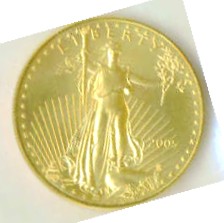
American Eagle Gold Coin
Here’s a story which could prove to be interesting. The government would rather confiscate coins than make money. (read the entire story linked via title bar)
“PHILADELPHIA, Pennsylvania (AP) -- The U.S. Mint seized 10 Double Eagle gold coins from 1933, among the rarest and most valuable coins in the world, that were turned in by a jeweler seeking to determine their authenticity.
Joan S. Langbord plans a federal court lawsuit to try to recover them, her attorney, Barry H. Berke, said Wednesday. Langbord found the coins among the possessions of her father, longtime Philadelphia jeweler Israel Switt, who had acknowledged having sold some of the coins decades ago. She now operates her father's business.
{…}
In 2002, Sotheby's and numismatic firm Stack's auctioned off a 1933 Double Eagle coin for $7.59 million, the highest price ever paid for a coin. That Double Eagle, which is believed to have been part of a collection belonging to King Farouk of Egypt, surfaced when a coin dealer tried selling it to undercover Secret Service agents.”
I read where the government had opted to split the proceeds from that auctioned 1933 Double Eagle, a percent going to the government and the rest being kept by the private sector. In other cases the government simply confiscated these rare coins and turned them back into bullion.
“In its statement, the Mint said officials were still deciding what they would do with the seized coins, which are being held at a military fort. They said they had no plans to auction them but would consider saving "these historical artifacts" for public exhibits. Other double eagle coins seized in the past were melted down.”
If you wanted to purchase an authorized version of the United States Mint American Eagle 1 ounce gold coin through vendors at today’s fluctuating market, which prices are quoted on a moment to moment basis, it would be about $ 450.00, give or take a dollar. Pure gold bars are slightly less as are South African Krugerrands. I won’t get into a discussion about the investment value of gold, leaving that up to others who are far more knowledgeable. I won’t get into the looming court battle over confiscation of private property on the grounds that these coins may or may not have left the United States Mint improperly way back in 1933; however, the most recent private owners could not have been a party to any wrong doing had those coins been stolen or improperly acquired in any case.
At issue is the stupidity of Mint officials for not having permitted Joan S. Langbord to auction off the 10 most rare coins in the world for what ever phenomenally outrageous price the market would bare; remembering that a single coin from that same group was sold for $7.59 million only a couple of years ago. After the legal battles in the courts and after the bargaining in the back room to come to an agreement there would be a settlement and a dividing up of the proceeds from auction.
I’m no rocket scientist and have a limited ability with numbers; all the same, if all ten coins together brought in only a million dollars at auction, and that is such a ridiculously low figure, then assuming that the government agreed to a 50/50 split; then our United States Mint would walk away with a half million dollars instead of $4,500.00. Part of the agreement might stipulate that one of the 10 coins be kept off the auction for the stated purpose of being displayed as a part of the Smithsonian Institution for public display as had been alluded to while the rest were put up for auction.
It would seem that sharper minds must work at that copier manufacturer or that place in the mall with all the neat gadgets than work at the United States Mint. Which would you rather have, an ounce of melted down pure gold or a rare and beautiful coin worth millions in the open market?

No comments:
Post a Comment